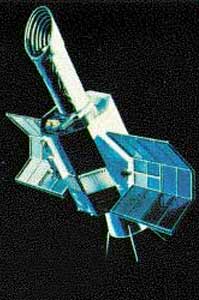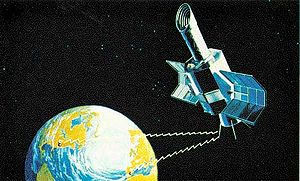International Ultraviolet Explorer
International Ultraviolet Explorer (IUE) was an astronomical observatory satellite primarily designed to take ultraviolet spectra. The satellite was a collaborative project between NASA, the UK Science Research Council and the European Space Agency (ESA).
| Organization | (NASA, ESA, Science Research Council ) |
|---|---|
| Wavelength regime | Ultraviolet |
| Orbit height | 42,000 km apogee, 26,000 km perigee |
| Orbit period | One day (geosynchronous orbit) |
| Launch date | January 26, 1978 |
| End of operations | September 30, 1996 (deliberately shut down, remains in orbit) |
| Mass | 672 kg |
| Other names | None |
| Webpage | ESA Science and Technology |
| Physical characteristics | |
| Telescope style | Ritchey-Chretien Cassegrain reflector |
| Diameter | 45 cm |
| Focal ratio | f/15 |
| Instruments | |
| Two echelle spectrographs | 115 nm to 198 nm and 180 nm to 320 nm spectral range |
IUE was first proposed in early 1964, by a group of scientists in the United Kingdom, and was launched on January 26, 1978 aboard a NASA Delta rocket. The minimum mission lifetime was initially set for 3 years, but it far exceeded the expectations of the astronomers and engineers and was eventually switched off in 1996 (for budgetary reasons, while still functioning at near original efficiency), exceeding the planned life by more than a factor of 6. It was the first space observatory to be operated in real time by astronomers who visited the groundstations in the United States and Europe. Astronomers made over 104,000 observations of different objects using IUE, including planets, comets, stars, interstellar gas, supernovae, planetary aurorae, galaxies, and quasars.
Project History
The concept for an ultraviolet spectographic astronomnical satellite was first proposed to ESRO, the fore-runner to ESA, by a group of British scientists in 1964. The proposal at the time was beyond the technological capability of ESA and so the concept was offered by Robert Wilson to NASA, who took up the idea and developed it as SAS-D (Small Astronomy Satellite-D). SRC joined the resulting project and provided the Vidicon cameras for the spectrographs as well as software for the scientific instruments. ESA provided the solar arrays to power the spacecraft as well as a ground observing facility in Villafranca del Castillo, Spain. NASA contributed the telescope, spectrograph, and spacecraft as well as launching facilities and a second ground observatory in Greenbelt, Maryland at the Goddard Space Flight Center.
According to the agreement setting up the project the observing time would be divided between the contributing agencies with 2/3 to NASA, 1/6 to ESA and 1/6 to the UK's Science Research Council.
Scientific Firsts and Discoveries
- The first detection of the existence of an aurora in Jupiter
- The first detection of sulphur in a Comet
- The first quantitative determination of water loss in a Comet (some 10 tons per second)
- The first evidence for strong magnetic fields in chemically peculiar stars
- The first orbital radial velocity curve for a WR star allowing its mass determination
- The first detection of hot dwarf companions to Cepheid variables
- The first observational evidence for semi-periodic mass loss in high mass stars
- The first discovery of high velocity winds in stars other than the Sun
- The first identification of the progenitor of any supernova in history (Supernova 1987A)
- The discovery of starspots on late type stars through the Doppler mapping techniques
- The discovery of large scale motions in the transition regions of low gravity stars
- The discovery of high temperature effect in stars in the early stages of formation
- The discovery of high velocity winds in cataclysmic variables
- The discovery of the effect of chemical abundance on the mass loss rate of stars
- The first determination of a temperature and density gradient in a stellar corona outside the Sun
- The first detection of gas streams within and outflowing from close binary stars
- The determination that no nova ejects material with solar abundances
- The discovery of the "O-Ne-Mg" novae, where the excess of these elements can be directly traced to the chemical composition of the most massive white dwarfs
- The discovery of a ring around SN 1987A, a leftover from previous evolutionary stages
- The first direct detection of galactic halos
- The first observations of extragalactic symbiotic stars
- The first uninterrupted light curves of stars for more than 24 hours continuously
- The first detection of photons at wavelengths less than 50 nm from any astronomical source apart from the Sun
- The first direct determination of the size of the active regions in the nuclei of Seyfert galaxies (mini-quasars)
- The first detection of a transparent sightline to a quasar at high redshift allowing the first abundance determination of the intergalactic medium in the early Universe
- The first astronomical and satellite facility ever, to deliver fully reduced data within 48 hours to the worldwide community of scientists
- The creation of the first worldwide astronomical reduced-data archive delivering 44,000 spectra per year (5 spectra per hour) to astronomers in 31 countries
References
- Exploring the Universe with the IUE Satellite ed. Y. Kondo 1987,1989 ISBN 90-277-2380-X
- ESA Science and Technology: International Ultraviolet Explorer
| Previous Mission: ISSE 1 |
Explorer program | Next Mission: HCMM |

